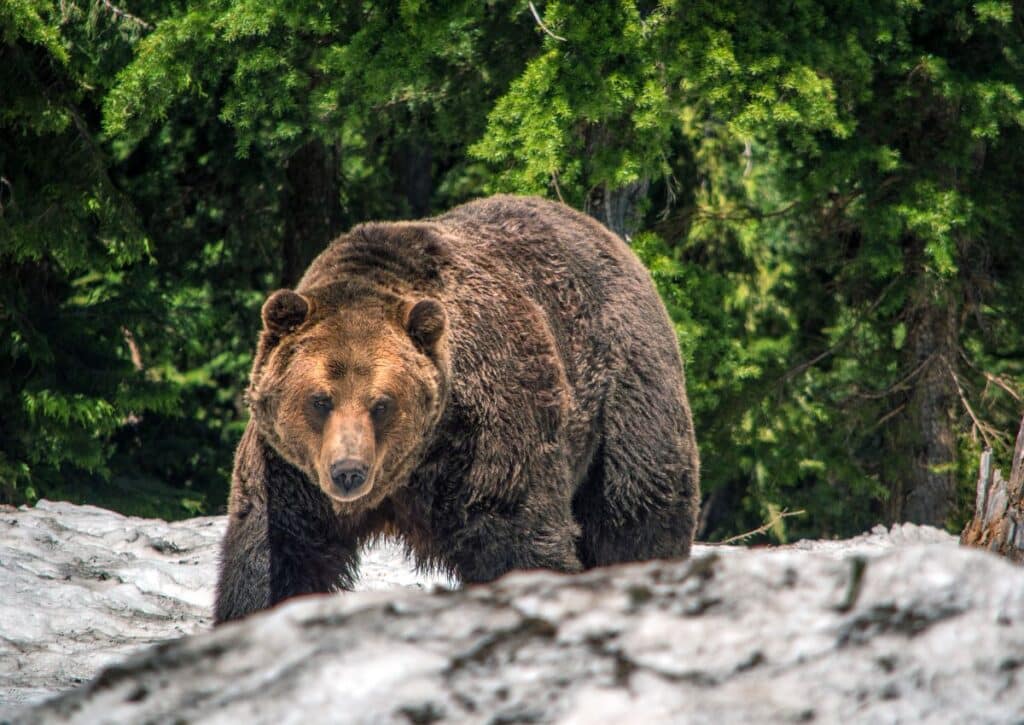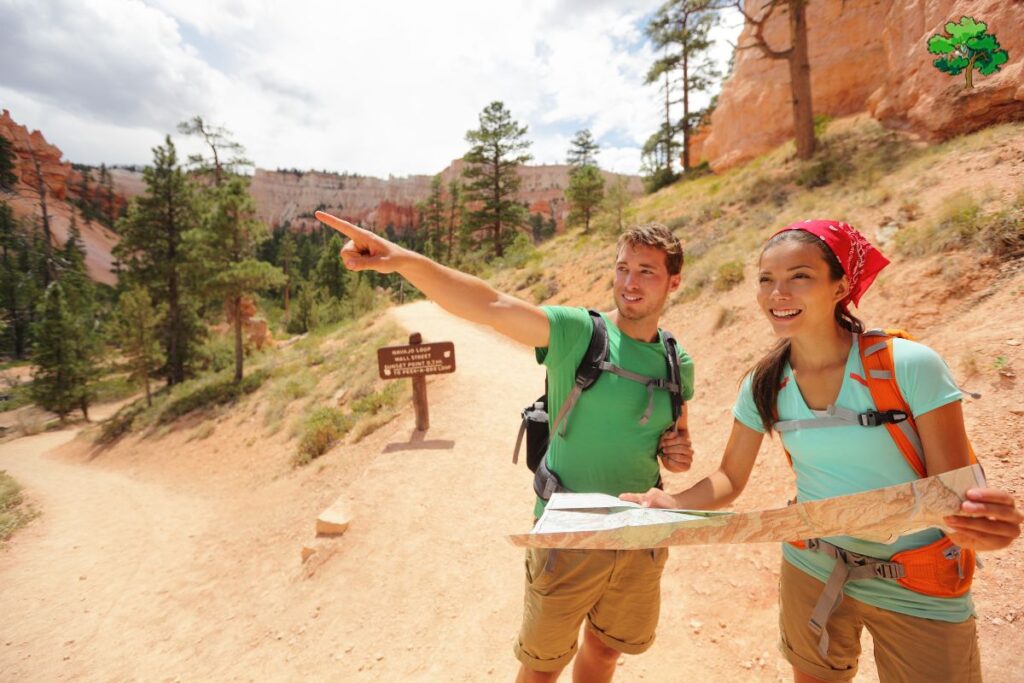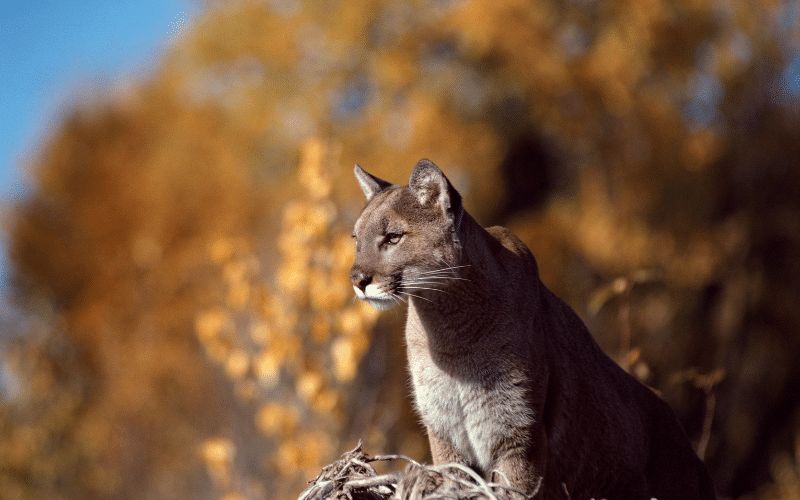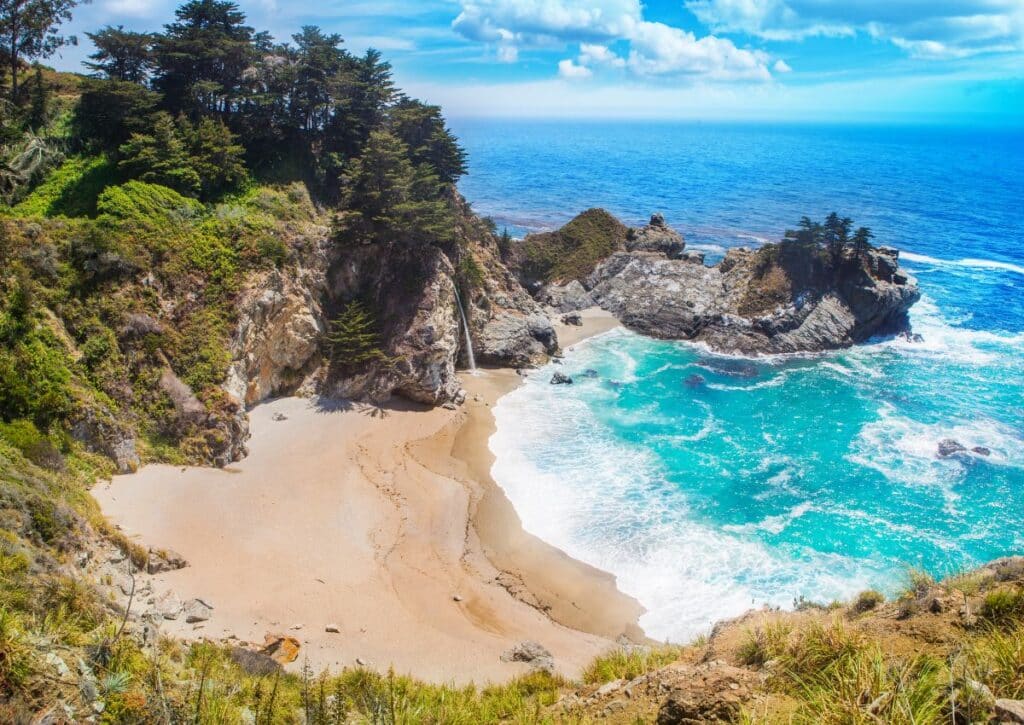Discover 11 North American national parks that have grizzly bears in our thrilling viewing guide!
Ready for a bear of an adventure? Imagine stepping into the vast expanse of America’s national parks, where the grizzly bear is not just a symbol on a park sign, but a living, breathing part of the wilderness. These parks aren’t just pretty postcards; they’re the stomping grounds of one of nature’s most impressive powerhouses: the grizzly.
From the moment we tiptoed into our first park, eyes wide with anticipation, it’s been a series of unforgettable encounters. Grizzlies roaming freely, foraging, and sometimes, if you’re as lucky as we’ve been, locking eyes with you. It’s heart-pounding, it’s awe-inspiring – it’s the kind of natural connection you can’t find just anywhere.
Buckle up for a cross-country trek where each park promises not just trails and vistas, but the thrill of spotting these mighty bears in their home territory. And we’re not keeping these spots secret; we’re sharing our personal playbook of 11 national parks where grizzlies are the stars and we’re just the audience with binoculars.
Whether you’re a grizzled bear-watching veteran or a newbie with a new lens, this guide has got you covered. So grab your bear spray and let’s hit the trails – adventure, and possibly a grizzly or two, awaits!
Grizzly Bears: An Overview
Grizzlies, a term often used interchangeably with brown bears, belong to the species Ursus arctos. These magnificent mammals are renowned for their impressive stature and commanding presence in the wild terrains they inhabit.
At first glance, the grizzly’s powerful build is evident. Their broad shoulders, accented by a pronounced hump, are a testament to the strength residing in their forelimbs.
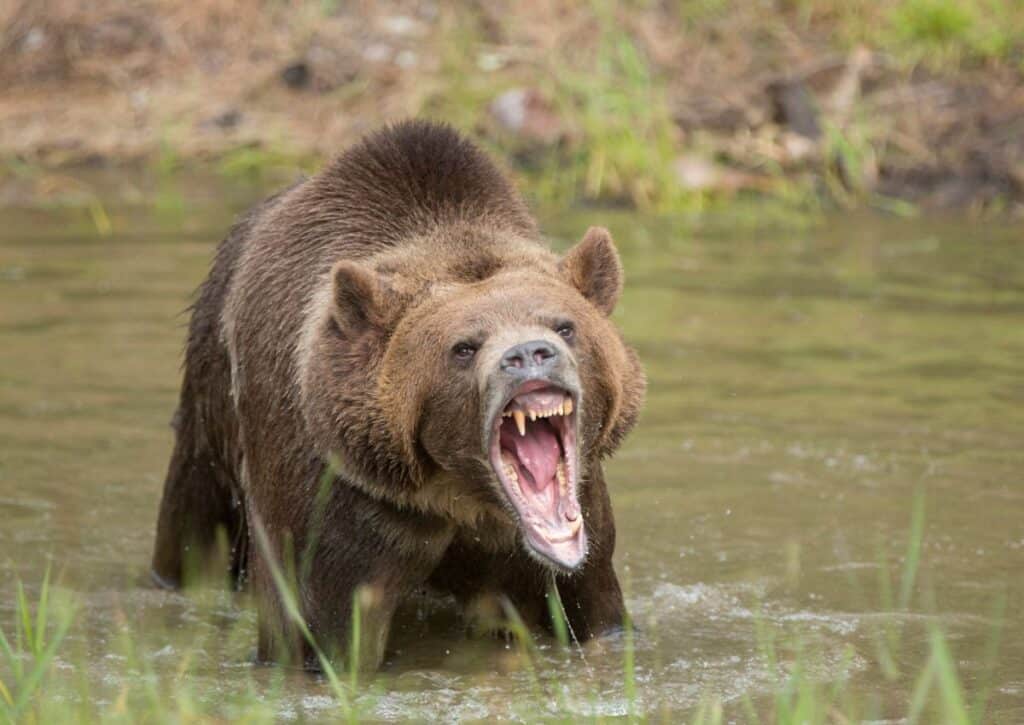
This hump, made of powerful muscles, aids them in digging and capturing prey. Their robust limbs, combined with their strong and agile bodies, allow them to cover ground quickly when needed, despite their massive size.
A grizzly’s coat is a marvel in itself. It varies in color, with shades ranging from a shimmering blonde to a deep, rich brown.
This dense fur not only protects them from the elements but also from potential injuries during confrontations, either with prey or other bears.
When distinguishing a grizzly from the more commonly found black bear, several features stand out. Apart from their notably larger size, grizzlies possess a dished or concave face profile.
Additionally, their claws, which are significantly longer and straighter than those of black bears, are adept tools for digging and grasping.
Understanding the grizzly bear is crucial for anyone hoping to catch a glimpse of them in the wild or simply appreciate their role in the ecosystem.
Their physical attributes, combined with their keen instincts, position them as one of nature’s most iconic and respected predators.
Our Top 10 Parks to See Grizzly Bears
Grizzly bears are among North America’s most iconic wildlife, and several national parks provide the perfect setting to observe them.
Each location offers its own unique experience and environment. Here, we present a concise list of the top 10 parks we’ve had grizzly bear sightings.
Yellowstone National Park
Yellowstone National Park, encompassing parts of Wyoming, Montana, and Idaho, is a crown jewel in the U.S. national park system.
Renowned for its geothermal features like Old Faithful and the Grand Prismatic Spring, it’s also celebrated as one of the premier habitats for the grizzly bear.
With a history that traces back to the very origins of America’s national parks, Yellowstone’s commitment to conservation has made it a haven for wildlife enthusiasts and grizzly bear aficionados.
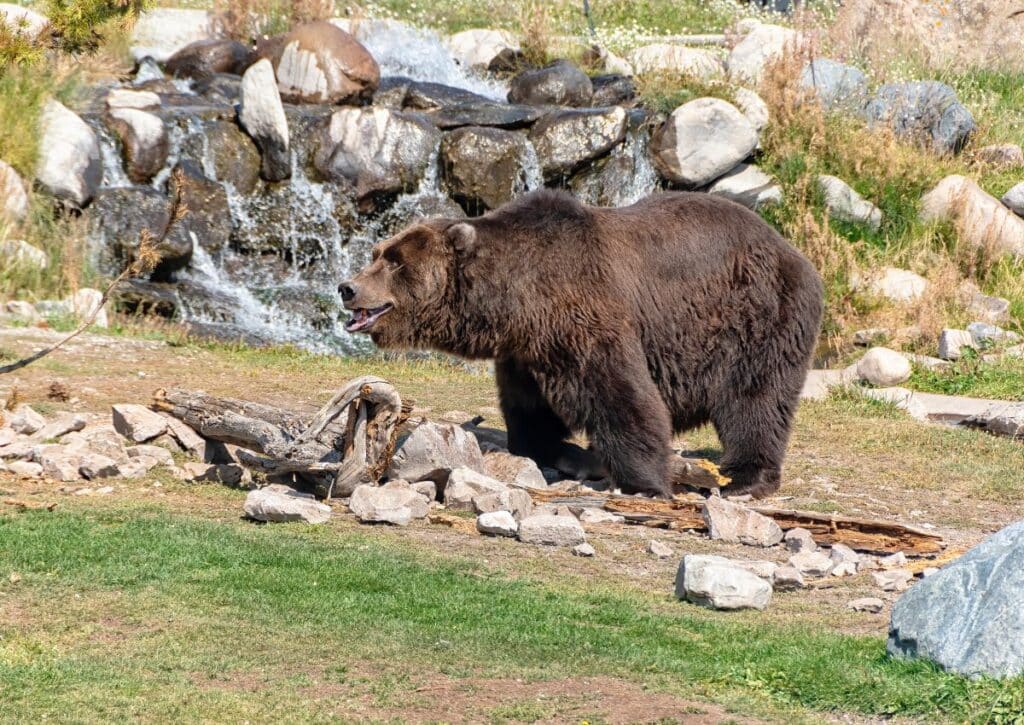
The park stretches over 2.2 million acres, offering a mosaic of habitats suitable for grizzlies.
From the sweeping Lamar and Hayden Valleys, often dubbed the ‘Serengeti of North America’, to the dense coniferous forests and pristine river valleys, there’s no shortage of places where one might encounter these magnificent creatures.
For those specifically seeking a grizzly sighting, the early morning and late afternoon hours are often the most fruitful.
During these times, grizzlies can be seen foraging in meadows, hunting for fish in the park’s many rivers, or perhaps even teaching their cubs the ways of the wild.
The Dunraven Pass and the areas around Fishing Bridge are particularly known for their grizzly activity.
Yellowstone’s vast expanse is home to a diverse array of other wildlife. Bison herds, wolf packs, elk, and a plethora of bird species make the park a true wildlife treasure trove.
Yellowstone’s sprawling landscapes and the presence of grizzlies make it a must-visit for anyone wishing to experience the wild heart of North America.
Grand Teton National Park
Just south of Yellowstone lies another gem of the American national park system: Grand Teton National Park.
Named after its most prominent mountain range, the Teton Range, this park in Wyoming is more than just a spectacle of rugged peaks, alpine lakes, and dense forests; it’s also a thriving habitat for the grizzly bear.
Grand Teton covers an area of approximately 310,000 acres, with a landscape dramatically different from its northern neighbor.
The jagged peaks of the Teton Range rise abruptly from the valley floor, casting shadows over serene glacial lakes like Jenny Lake and Jackson Lake.
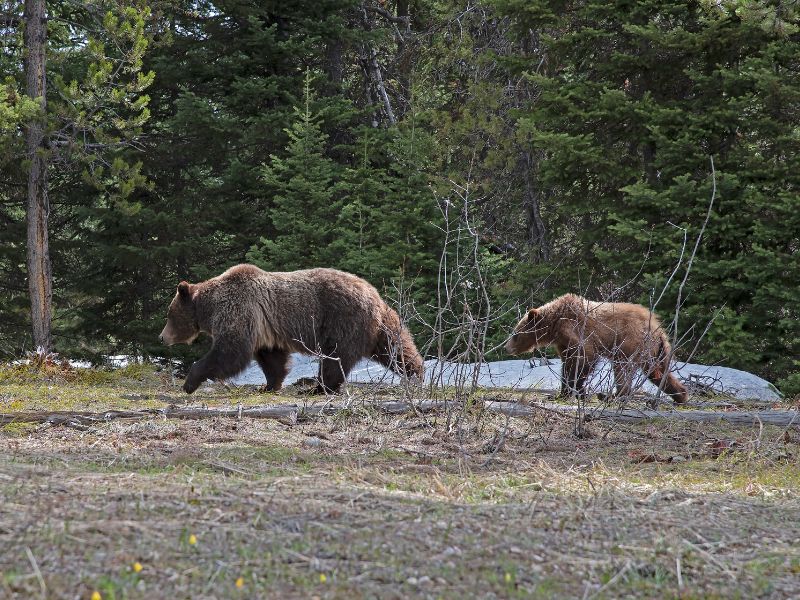
It’s against this dramatic backdrop that grizzlies roam, making for some truly breathtaking wildlife viewing experiences.
For visitors hoping to spot a grizzly, the areas around Willow Flats and Oxbow Bend are particularly promising. These regions offer a mix of open meadows and dense vegetation, providing ideal foraging grounds for bears.
Early mornings and dusk, when the park’s wildlife is most active, present the best opportunities for sightings.
As with all wild animals, safety and respect are paramount when in grizzly territory. Keeping a safe distance, making noise when hiking to alert bears of human presence, and storing food securely are vital practices to ensure both human and bear safety.
Beyond its bear population, Grand Teton National Park is a haven for diverse wildlife, from moose grazing near the water’s edge to eagles soaring above the peaks.
But the sight of a grizzly bear, with the magnificent Teton Range in the background, is an image that resonates deeply, reminding us of the untouched beauty that still exists in certain pockets of our world.
Glacier National Park
Glacier National Park is often referred to as the “Crown of the Continent.” Its vast landscapes, encompassing over a million acres, are a harmonious blend of glacial valleys, pristine lakes, and towering mountain ranges.
But what truly amplifies its allure for many visitors is its thriving grizzly bear population.
The park’s expansive wilderness offers grizzlies a sanctuary, free from most human-induced disturbances.
These areas of untouched beauty, with dense forests interspersed with alpine meadows, are vital to the grizzly’s survival, offering them abundant food sources and safe breeding grounds.
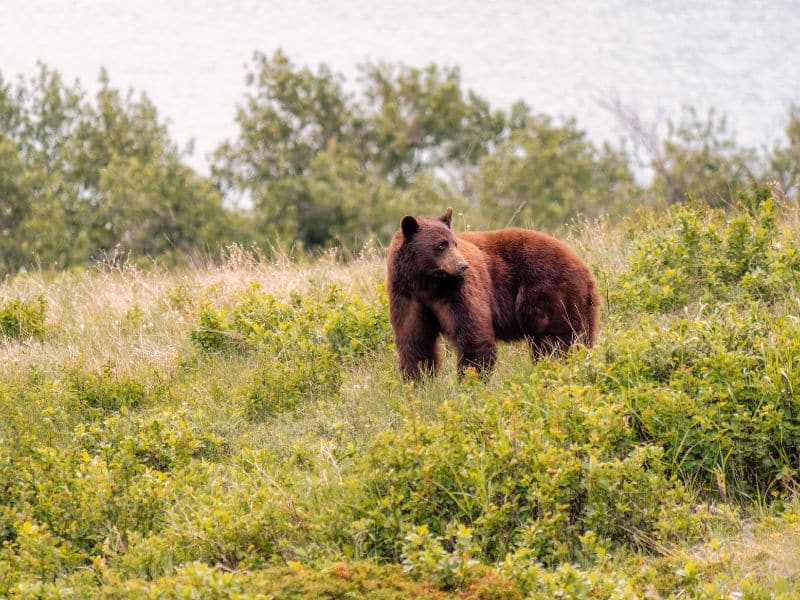
For those eager to witness the grandeur of grizzlies, areas such as the Many Glacier Valley and Logan Pass are prime locations.
The park’s extensive trail system, like the Highline Trail and the Grinnell Glacier Trail, often affords hikers the chance to spot these bears from a distance, especially during early morning or late evening hours when they are most active.
However, with the thrill of being in grizzly territory comes the responsibility to prioritize safety.
It’s essential for visitors to carry bear spray, hike in groups, and make noise to avoid surprising a bear.
Proper food storage and adherence to park guidelines also play a crucial role in ensuring the safety of both visitors and the bear population.
While the grizzly is undoubtedly a significant attraction, Glacier National Park is teeming with other wildlife, from mountain goats navigating steep cliffs to elusive lynxes prowling the underbrush.
But the sight of a grizzly, against the backdrop of the park’s awe-inspiring glacial landscapes, offers a quintessential wild experience that stays etched in one’s memory.
Also Read: 12 STOPS ON A SPOKANE TO GLACIER NATIONAL PARK ROAD TRIP (ITINERARY AND TIPS INCLUDED)
Banff National Park
Banff National Park, a jewel in the Canadian Rockies, captures the essence of Canada’s wild heart.
Situated in Alberta, this vast expanse is not just a paradise for outdoor enthusiasts; it’s a vital habitat for the grizzly bear.
Dotted with iconic landmarks like Lake Louise, Moraine Lake, and the Icefields Parkway, Banff’s varied ecosystems provide the grizzly with everything from dense, coniferous forests to open meadows filled with berries.
The park’s Bow Valley, with its rippling streams and rich vegetation, serves as one of the primary habitats for these bears.
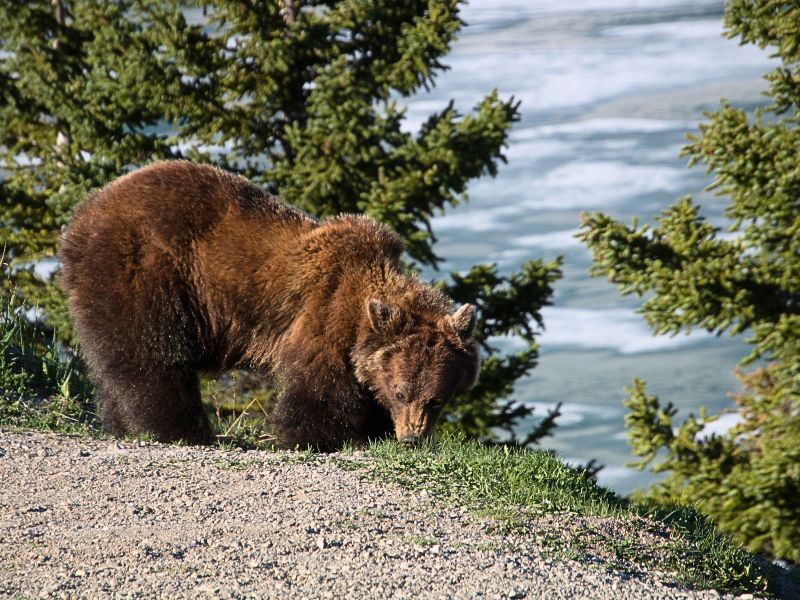
Here, they fish, forage, and rear their young, shielded by the towering peaks that define Banff’s skyline.
Recognizing the significance of this habitat, Banff has been at the forefront of conservation initiatives in the Rockies.
Beyond standard safety measures, the park is invested in innovative solutions that prioritize bear well-being.
One noteworthy endeavor is the establishment of wildlife overpasses and underpasses. These structures, first of their kind in the world, allow bears and other wildlife to safely cross highways, preserving their natural movement patterns and reducing the risk of vehicular collisions.
Moreover, Banff’s commitment to its grizzly population is evident in its ongoing research collaborations.
Scientists and researchers work diligently within the park, studying bear behavior, monitoring populations, and ensuring that their habitats remain undisturbed, especially during crucial periods like hibernation.
For visitors, the chance to witness a grizzly in the wild expanses of Banff is a memory for the ages. It’s a potent reminder of the rich tapestry of life that thrives in this park, and the collective efforts ensuring it remains a sanctuary for generations to come.
Kootenay National Park
Kootenay National Park is a lesser-known but equally captivating wilderness reserve in the Canadian Rockies.
This park’s contrasting landscapes, which stretch from arid grasslands to glacial expanses, offer a rich mosaic of habitats. And it’s within these varied terrains that the grizzly bear has carved out its niche.
Kootenay’s unique topographical blend plays a pivotal role in supporting a robust grizzly population. The open grasslands, bathed in sunlight, offer bears a bounty of berries and vegetation during warmer months.
Meanwhile, the dense forests that climb up the mountainsides provide shelter and a vast hunting ground, where grizzlies can be seen pursuing prey or foraging for nuts and roots.
But it’s not just the food that draws these predators to Kootenay. The park’s numerous waterways, ranging from cascading waterfalls to serene rivers, are prime fishing spots.

Here, especially during salmon runs, grizzlies can be observed displaying their fishing prowess, plucking fish from the waters with remarkable agility.
Visitors to Kootenay are often struck by its raw, untamed beauty—a landscape where nature reigns supreme.
Trails like the Dog Lake Trail or the Rockwall Trail not only offer panoramic views of the park’s diverse environments but also increase the chances of spotting wildlife, including the elusive grizzly.
While Kootenay might be overshadowed by its more famous neighbors, it stands as a testament to Canada’s commitment to preserving its natural heritage.
Here, in this rugged expanse, grizzlies and other wildlife continue to thrive, offering visitors a genuine taste of the wild Canadian Rockies.
Gates of the Arctic National Park and Preserve
In the remote reaches of Alaska, beyond the well-trodden paths and popular tourist spots, lies the Gates of the Arctic National Park and Preserve.
A pristine wilderness encompassing over eight million acres, it’s a land where the formidable Arctic environment reigns supreme.
Positioned entirely within the Arctic Circle, this park offers intrepid travelers a rare glimpse into one of the planet’s last untouched frontiers.
Gates of the Arctic isn’t just a testament to nature’s raw power; it’s also a refuge for a variety of wildlife, including the grizzly bear.
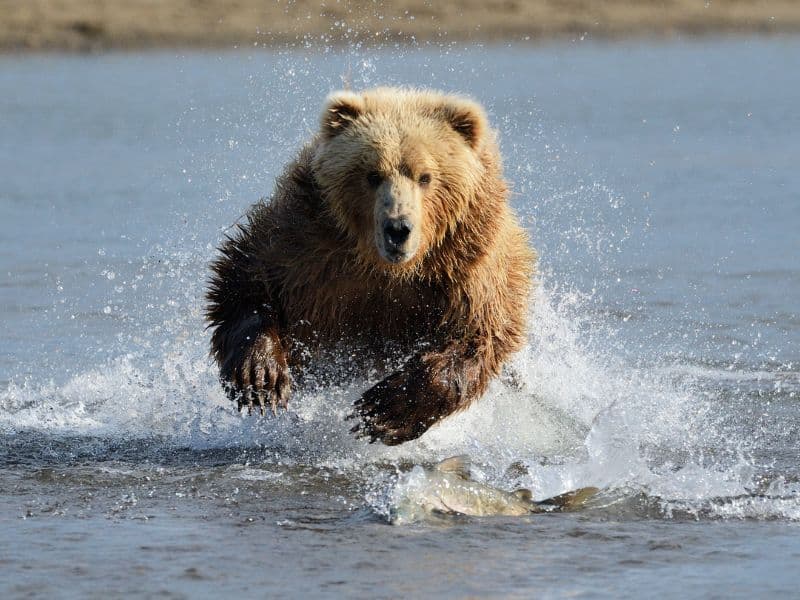
Unlike more southern habitats, the park’s vast expanses mean that grizzly populations are dispersed. However, their presence is undeniable.
Whether it’s against the stark backdrop of the tundra, with its mosaic of colorful lichens and mosses, or along the pristine riverbanks that meander through the park, grizzlies have etched out a life in this challenging environment.
Given the park’s immense size and the bears’ widespread distribution, spotting a grizzly here is less about probability and more about patience and reverence for the wilderness.
Those who venture into this region, armed with a respect for its isolation and an appreciation for its subtle beauty, might be rewarded with a rare sight: a grizzly moving gracefully across the Arctic landscape, a symbol of resilience and adaptability.
For many, a journey to the Gates of the Arctic is about more than just wildlife sightings. It’s an immersion into a world that remains largely unaltered by human hands.
Yet, for those fortunate enough to observe a grizzly in this vast wilderness, it’s a poignant reminder of nature’s grandeur and the importance of preserving these last bastions of wildness.
Lake Clark National Park and Preserve
Deep in the heart of Alaska, away from the urban bustle, lies Lake Clark National Park and Preserve — a wild mosaic of shimmering lakes, rugged mountains, and verdant forests.
While the park’s landscapes are nothing short of breathtaking, it’s the resident brown bears that truly steal the show.
Often used interchangeably with the term “grizzly,” the brown bears of Lake Clark are a sight to behold.
These majestic creatures have found a sanctuary within the park’s borders, particularly drawn to the coastal sedge meadows and the numerous rivers coursing through the land.
These habitats offer a buffet of resources, from the lush grasses and sedges of the meadows to the fish-rich waters of the rivers.
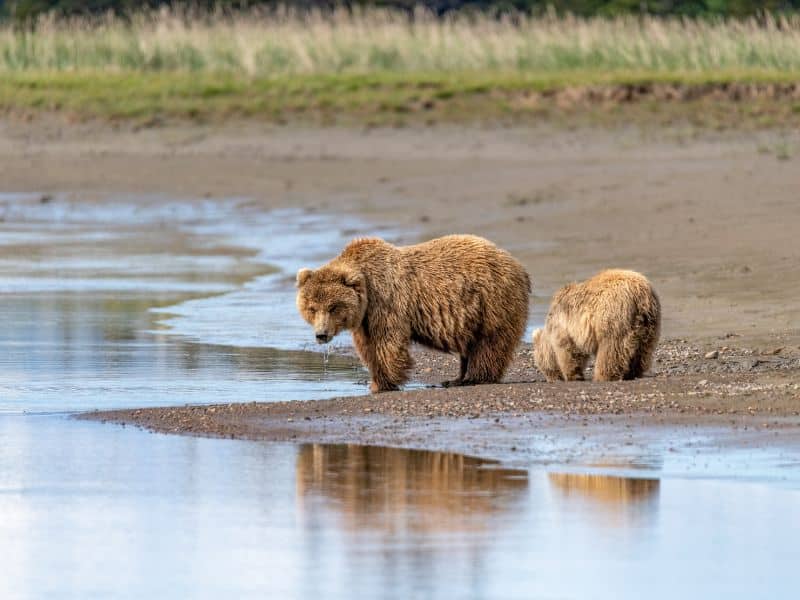
A pinnacle moment for wildlife enthusiasts visiting Lake Clark is the salmon spawning season. During this period, the rivers and streams teem with salmon returning to their freshwater spawning grounds.
Where there are salmon, there are bound to be bears. Observing these powerful predators skilfully snatch salmon from the water or teach their young the art of fishing is an unforgettable spectacle.
But it’s not just the food that draws bears to Lake Clark. The park’s vastness and relative remoteness ensure that the bears have ample space to roam, forage, and raise their offspring without the constant threat of human interference.
This level of protection and abundance has made Lake Clark one of the best places in Alaska — and arguably the world — to witness brown bears in their natural habitat.
For travelers with a penchant for unspoiled nature and charismatic wildlife, Lake Clark National Park and Preserve stands as a testament to the wild beauty of Alaska, with the brown bear as its undisputed ambassador.
Katmai National Park and Preserve
Katmai National Park and Preserve is a treasure trove of volcanic landscapes, pristine waterways, and diverse wildlife.
Among its many wonders, the park is most renowned for one awe-inspiring spectacle: its thriving population of brown bears.
The bears of Katmai are not just a mere attraction; they are the very heart and soul of the park.
With numbers that rival some of the densest bear populations globally, Katmai offers wildlife enthusiasts an unparalleled opportunity to witness these magnificent creatures in their natural element.
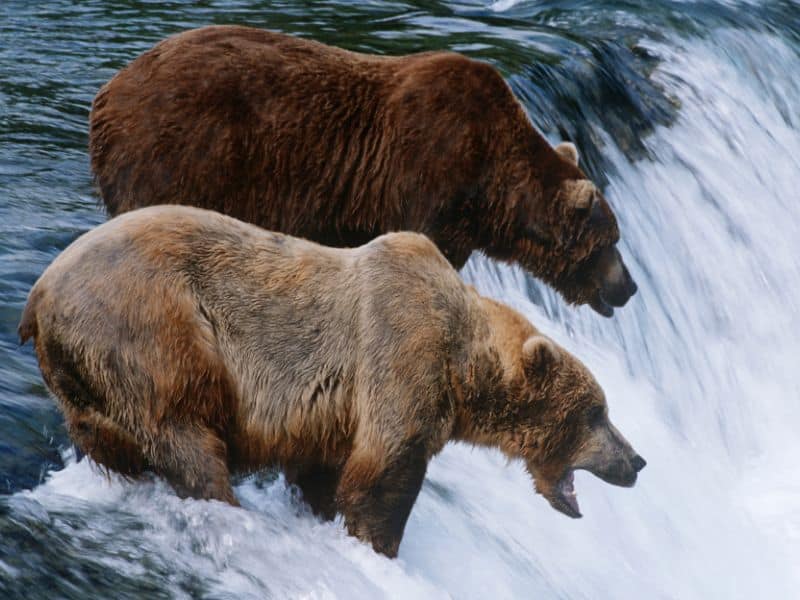
The epicenter of bear activity in the park is undoubtedly the Brooks River and the iconic Brooks Falls.
These locations become a hub of action, especially during the salmon run. As salmon journey upstream to spawn, they must navigate the cascading waters of Brooks Falls – a challenging endeavor that becomes a feast for the waiting bears.
The sight of these powerful predators lunging at leaping salmon, skillfully catching them mid-air or grappling for the best fishing spots, is a scene that captivates and enthralls thousands of visitors each year.
While the salmon run typically peaks in July, bear sightings at Brooks Falls continue through the summer and into early fall.
Elevated viewing platforms strategically positioned near the falls ensure that visitors get a front-row seat to the action, all while maintaining a safe and respectful distance from the wildlife.
Katmai National Park and Preserve isn’t just about the sheer number of bears or the drama at Brooks Falls.
It’s about the intimate glimpses it offers into the lives of these creatures — from mothers tenderly caring for their cubs to young bears playfully wrestling by the river’s edge.
For those seeking an authentic and immersive bear-watching experience, Katmai stands unparalleled in its majesty and magic.
Wrangell-St. Elias National Park and Preserve
Encompassing a staggering 13.2 million acres, Wrangell-St. Elias National Park and Preserve holds the distinction of being the largest national park in the United States.
Tucked away in southeastern Alaska, this park is a vast tapestry of glaciers, towering mountain peaks, and expansive valleys.
Amidst this rugged beauty and untouched wilderness thrives one of the most iconic symbols of Alaskan wildlife: the grizzly bear.
Alaska is renowned for its dense bear population, and Wrangell-St. Elias, with its sprawling landscapes and varied ecosystems, plays a vital role in supporting a significant portion of these magnificent creatures.
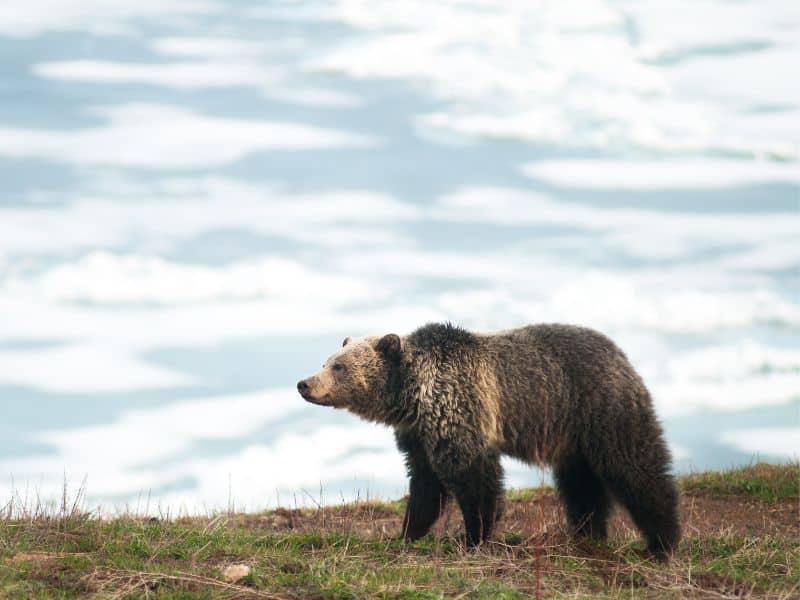
Here, grizzlies roam with a freedom and expanse that is rare to find elsewhere. From the alpine meadows bursting with seasonal flora to the river valleys teeming with fish, the park provides a smorgasbord of resources that sustains and nourishes the grizzly population.
For visitors to Wrangell-St. Elias, spotting a grizzly bear is an experience imbued with both excitement and reverence.
Given the park’s vastness, these encounters are often serendipitous — a lone bear foraging along a riverbank, a mother leading her cubs through a meadow, or the distant silhouette of a bear against the backdrop of snow-capped peaks.
While the park’s remoteness might pose challenges in terms of accessibility, it’s this very seclusion that makes Wrangell-St. Elias a sanctuary for grizzlies.
The minimal human intrusion ensures that the bears can lead a life that’s as natural and undisturbed as possible.
North Cascades National Park
Set amidst the rugged beauty of Washington State, North Cascades National Park is a realm of snow-capped peaks, ancient forests, and shimmering alpine lakes.
Yet, for all its breathtaking splendor, one aspect remains notably elusive: the presence of the grizzly bear.
Historically, the verdant valleys and thick woods of the North Cascades were home to a thriving population of grizzlies.
However, as years passed, their numbers began to diminish, and today, sightings are rare, if not exceptional.
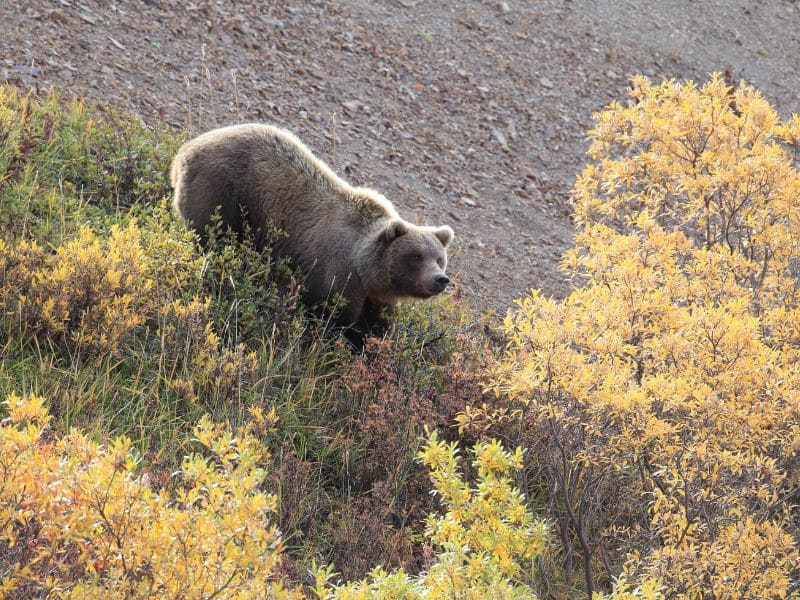
While the reasons for their decline are multifaceted, including habitat loss and human encroachments, the consensus among conservationists is clear: something needs to be done to ensure the survival of this iconic species in the region.
Recognizing the grizzly’s pivotal role in the ecosystem and its significance as a symbol of the American wilderness, a concerted effort is underway to reverse its waning presence in the North Cascades.
Conservationists, park officials, and researchers have come together in a collaborative endeavor to understand the challenges faced by the grizzlies and to devise strategies to bolster their numbers.
Central to this initiative is the collection of data, which involves tracking the bears’ movements, studying their habitats, and monitoring their health.
This invaluable information forms the foundation upon which restoration plans are built.
Among the proposed strategies are the introduction of bears from healthier populations and creating more secure habitats where they can thrive without the constant threat of human interference.
For visitors to North Cascades National Park, the ongoing efforts to restore the grizzly population add a layer of significance to their experience.
Beyond the vistas and trails, there’s the underlying narrative of a region committed to righting past wrongs and ensuring a brighter future for its native wildlife.
The North Cascades is not just a testament to the beauty and resilience of nature but also a beacon of hope for conservation and coexistence in the modern age.
Denali National Park
Denali National Park and Preserve encompasses over 6 million acres of pristine wilderness.
Apart from being home to North America’s tallest peak, Mount Denali, this park is also a haven for an array of wildlife, including grizzly bears.
In Denali, grizzly bears can be spotted roaming the vast tundra landscapes, foraging for berries, digging for ground squirrels, or fishing in streams.
The park’s diverse ecosystem, with its combination of forest, tundra, and snowy mountains, provides an ideal habitat for these bears.
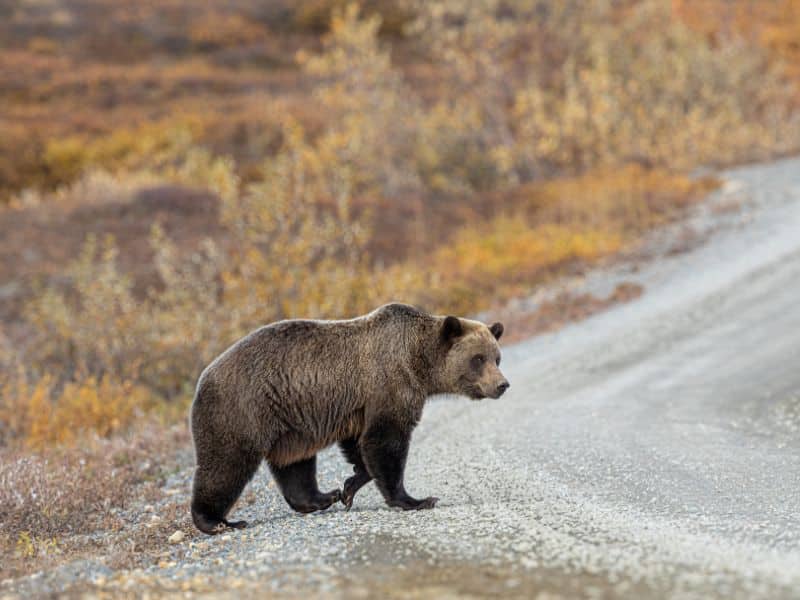
Due to the park’s expansive nature, the bears have a vast territory to wander, making sightings a thrilling, albeit sometimes rare, experience for visitors.
If you’re planning to visit Denali with the hopes of spotting a grizzly, consider taking one of the park’s official bus tours.
These tours, which traverse the Denali Park Road, offer some of the best opportunities for wildlife viewing. Throughout the journey, experienced guides provide insights into the behavior and ecology of the park’s residents, enhancing the overall experience.
However, as with any wild setting, it’s crucial to remember safety guidelines.
If hiking or camping in Denali, always maintain a safe distance from any wildlife, store food securely, and make noise while moving to avoid surprising a bear.
With its breathtaking landscapes and rich biodiversity, Denali National Park and Preserve is not just a testament to nature’s grandeur but also a vital sanctuary for grizzly bears and many other iconic North American species.
10 Tips for Safe Bear Viewing
A journey to observe grizzly bears in their natural habitat is an experience of a lifetime.
However, ensuring that both you and the bears remain safe during these encounters is paramount. Here are some essential tips to help you enjoy bear watching responsibly:
- Maintain a Safe Distance: It can’t be emphasized enough: always keep at least 100 yards away from grizzly bears. If they change their behavior due to your presence, you’re too close.
- Bear Spray is Essential: When traversing bear country, it’s prudent to carry bear spray. More importantly, familiarize yourself with its operation before heading out. It’s a powerful deterrent in the unlikely event of a bear charge.
- Travel in Groups: Solo adventures might sound tempting, but in bear territories, there’s safety in numbers. Bears are naturally wary and are less likely to approach larger groups.
- Stick to Designated Trails: Staying on established paths minimizes the risk of inadvertently stumbling upon a bear, especially when they’re feeding or with cubs.
- Noise is Your Friend: Especially in areas with thick underbrush or limited visibility, it’s advisable to make noise. Whether it’s talking loudly, singing, or using bear bells, these sounds alert bears to your presence, reducing surprise encounters.
- Respect the Wildlife: The wilderness is their home, and we are mere visitors. Avoid feeding, approaching, or attempting to interact with bears. Such actions can be dangerous for both humans and bears.
- Secure Your Food: Bears have an excellent sense of smell. Use bear-proof containers and store food away from sleeping areas when camping.
- Avoid Bear Hotspots During Peak Times: Areas like berry patches, carcasses, or salmon streams can be teeming with bears at certain times. It’s best to avoid these spots or be extra cautious.
- Educate Yourself: Before heading out, familiarize yourself with bear behavior and signs of their presence. Knowledge is power, especially when it comes to understanding potential risks.
- In Case of an Encounter: If you do encounter a bear, avoid direct eye contact, speak in a calm and firm voice, and slowly back away without turning your back to the bear.
Our adventures into the wild come with a responsibility to protect and preserve. By following these guidelines, you can ensure a memorable and safe bear-watching experience.
Which national parks have the most grizzly bears?
When it comes to sheer numbers, a few national parks distinctly stand out with dense grizzly bear populations. Here’s a breakdown of five parks with noteworthy grizzly bear counts:
- Yellowstone National Park: Holding the title as the primary stronghold for grizzlies in the contiguous U.S., Yellowstone boasts an estimated population of around 700 grizzlies. Stretching across Wyoming, Montana, and Idaho, its varied ecosystems create an ideal habitat for these giants.
- Katmai National Park and Preserve: Located in Alaska, Katmai is renowned for its vast population of brown bears, with numbers often cited around 2,200 bears. The Brooks River, in particular, offers iconic scenes of bears fishing for salmon.
- Glacier National Park: Nestled in Montana, Glacier National Park houses a population of approximately 300 grizzlies, making it another top destination for bear enthusiasts.
- Wrangell-St. Elias National Park and Preserve: Also in Alaska, this expansive park is home to a substantial bear population, with estimates suggesting around 1,500 grizzlies residing here.
- Banff National Park: Situated in the Canadian Rockies, Banff shelters a significant grizzly population, with numbers estimated at around 60-80 bears. It’s not just the sheer beauty of the landscapes here but also the promise of bear sightings that allure visitors.
It’s worth noting that while these numbers provide a snapshot, grizzly populations can fluctuate based on factors like food availability, habitat conditions, and conservation efforts. Always remember to view these magnificent creatures safely and responsibly.
What State Has the Most Grizzly Bears?
Alaska holds the distinction of having the most grizzly bears of any state in the U.S. With vast expanses of untouched wilderness and diverse habitats, it provides an ideal environment for these powerful creatures.
The grizzly bear population in Alaska is estimated to be between 30,000 to 40,000, significantly more than any other state.
While the contiguous U.S. has seen a resurgence of grizzly populations in places like Montana and Wyoming, their numbers are dwarfed by the massive population in Alaska.
Whether along its riverbanks during the salmon run or across its sprawling tundras, Alaska stands out as the premier destination for those hoping to witness these magnificent animals in the wild.
What Are the Chances of Seeing a Grizzly Bear in Yellowstone?
Yellowstone National Park is one of the top destinations for travelers hoping to spot a grizzly bear in the wild.
With an estimated population of around 700 grizzlies, the park boasts one of the densest concentrations of grizzlies in the contiguous U.S.
The chances of seeing a grizzly bear in Yellowstone can vary based on several factors:
- Time of Year: Spring (especially late April to early June) and fall are often the best times. In spring, bears are emerging from hibernation and can be seen in meadows and clearings. In fall, they’re actively foraging to prepare for the winter, making them more visible.
- Location: Some areas of the park, like the Hayden and Lamar Valleys, are renowned for frequent bear sightings due to the open landscapes and abundant food sources.
- Time of Day: Early morning and late evening are prime bear-watching times, as grizzlies are more active during cooler periods.
- Visitor Behavior: Staying quiet, patient, and keeping a safe distance can increase the chances of observing bears in their natural behavior. Using binoculars or a spotting scope can also enhance the experience.
- Guided Tours: Joining a guided wildlife watching tour can increase the chances as guides are knowledgeable about recent bear activity and the best viewing spots.
While there’s no guarantee of spotting a grizzly during a visit, many visitors do have the fortune of witnessing these majestic creatures.
However, it’s essential to prioritize safety, respect the bears’ space, and never approach or feed them.
Does Yosemite Have Grizzly Bears?
No, Yosemite National Park does not have grizzly bears. While grizzlies once roamed the vast landscapes of California, including the area that is now Yosemite National Park, they have been extirpated from the state.
The last known grizzly bear in California was killed in the early 1920s.
Today, Yosemite is home to black bears, which can sometimes be confused with grizzlies due to their varied coat colors that range from black to brown.
It’s essential for visitors to be aware of black bears and practice safe food storage and handling to protect both the bears and themselves.
The grizzly bear remains an enduring symbol of California, as evident from its prominent place on the state flag, but alas, these majestic creatures no longer roam the state’s wild places.
What Eats a Grizzly Bear?
Grizzly bears, being apex predators, have very few natural threats in the wild. However, they are not invulnerable. Here’s a breakdown:
- Other Grizzly Bears: Adult male grizzlies can sometimes kill cubs, primarily to bring the female back into estrus so he can mate with her. This behavior is called infanticide.
- Wolves: While wolves typically target smaller prey, they can sometimes challenge a grizzly, especially when food sources like an elk carcass are involved. In most confrontations, the bears and wolves will try to avoid direct combat, but there have been instances where wolves have killed bear cubs.
- Humans: Historically and unfortunately, humans have been the most significant threat to grizzly bears. Hunting, habitat destruction, and conflicts with humans in developed areas have led to a significant decline in grizzly bear populations in many areas, especially outside of Alaska.
- Starvation and Disease: Though not predators in the traditional sense, starvation and disease can also claim the lives of grizzly bears, especially when food sources are scarce.
While grizzly bears face few natural predators, human activity and environmental changes pose significant threats to their survival.
Where are the most aggressive grizzly bears?
Certain coastal areas in Alaska, particularly around Kodiak Island, are home to some of the largest brown bears (often called Kodiak bears in this region), which are a subspecies of the grizzly bear.
These bears often have fewer negative interactions with humans due to the lower human population density, but when they do, their sheer size and power can make those encounters particularly dangerous.
Moreover, bears in regions with high salmon availability can become very territorial around food sources, leading to heightened aggressive behavior during feeding times.
Also, it’s often noted that grizzlies in the backcountry of the Greater Yellowstone Ecosystem, while not as large as their Alaskan cousins, can be more defensive, possibly because they’re not as accustomed to human presence as those in some more frequently visited areas.
It’s essential to recognize that “aggressiveness” can vary based on individual bears, circumstances, and encounters with humans.
However, in general, regions with high food competition or areas where bears aren’t as habituated to human presence can see more assertive bear behavior.
In Conclusion
The grandeur of grizzly bears epitomizes the raw beauty and power of North America’s wilderness.
Their presence reminds us of the vast stretches of land that, even in our modern age, remain wild, free, and governed by nature’s laws.
The national parks that serve as their homes offer not just picturesque landscapes but a window into the world of these awe-inspiring creatures.
Witnessing a grizzly bear in its natural setting is an experience that evokes a profound respect for nature and its inhabitants.
However, as we venture into their domains, it is our responsibility to approach with caution, prioritize safety, and above all, extend the respect and admiration these magnificent animals truly deserve.

